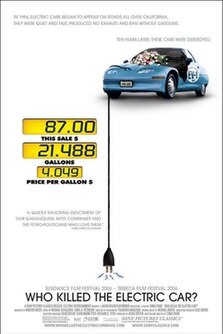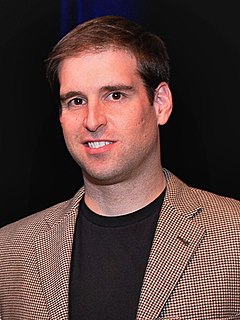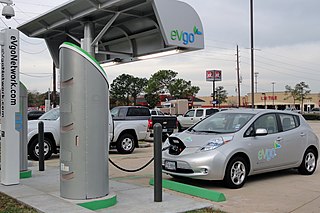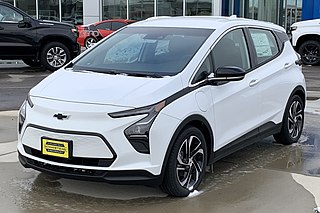
The General Motors Company (GM) is an American multinational automotive manufacturing company headquartered in Detroit, Michigan, United States. It is the largest automaker in the United States and was the largest in the world for 77 years, until losing the top spot to Toyota in 2008.

An electric vehicle (EV) is a vehicle that uses one or more electric motors for propulsion. It can be powered by a collector system, with electricity from extravehicular sources, or it can be powered autonomously by a battery. EVs include, but are not limited to, road and rail vehicles, surface and underwater vessels, electric aircraft and electric spacecraft.

AC Propulsion is a San Dimas, California, USA company founded in 1992 by Alan Cocconi, Wally Rippel, and Paul Carosa, that specializes in alternating current-based drivetrain systems for electric vehicles. It offers AC-induction traction motors. The company produces electric vehicle drive systems featuring high performance, high efficiency induction motors and integrated high power battery charging. Previously, they built an electric sports car, the tzero and the eBox, an electric conversion based on the Scion XB. They also develop prototype electric vehicles for OEM customers.

The General Motors EV1 was an electric car produced and leased by General Motors from 1996 to 1999. It was the first mass-produced and purpose-designed electric vehicle of the modern era from a major automaker and the first GM car designed to be an electric vehicle from the outset.

The Toyota RAV4 EV is an all-electric version of the popular RAV4 SUV produced by Toyota until 2014. Two generations of the EV model were sold in California, and to fleets elsewhere in the US, with a gap of almost ten years between them.

Practical electric vehicles appeared during the 1890s. An electric vehicle held the vehicular land speed record until around 1900. In the 20th century, the high cost, low top speed, and short-range of battery electric vehicles, compared to internal combustion engine vehicles, led to a worldwide decline in their use as private motor vehicles. Electric vehicles have continued to be used for loading and freight equipment and for public transport – especially rail vehicles.

Who Killed the Electric Car? is a 2006 American documentary film directed by Chris Paine that explores the creation, limited commercialization and subsequent destruction of the battery electric vehicle in the United States, specifically the General Motors EV1 of the mid-1990s. The film explores the roles of automobile manufacturers, the oil industry, the federal government of the United States, the California government, batteries, hydrogen vehicles and consumers in limiting the development and adoption of this technology.

Tesla, Inc. is an American multinational automotive and clean energy company headquartered in Austin, Texas. Tesla designs and manufactures electric vehicles, battery energy storage from home to grid-scale, solar panels and solar roof tiles, and related products and services. Tesla is one of the world's most valuable companies and remains the world's most valuable automaker with a market capitalization of more than US$760 billion. The company had the most worldwide sales of battery electric vehicles and plug-in electric vehicles, capturing 21% of the battery-electric market and 14% of the plug-in market in 2021. Through its subsidiary Tesla Energy, the company develops and is a major installer of photovoltaic systems in the United States. Tesla Energy is also one of the largest global suppliers of battery energy storage systems, with 3.99 gigawatt-hours (GWh) installed in 2021.

Martin Eberhard is an American engineer, inventor and entrepreneur who co-founded Tesla, Inc. with Marc Tarpenning in 2003. Eberhard served as Tesla's original chairman, and its CEO until late 2007. In 2015, he was inducted into the University of Illinois Engineering Hall of Fame.
The Sunraycer was a solar-powered race car designed to compete in the World Solar Challenge, the world's first race featuring solar-powered cars. The Sunraycer was a joint collaboration between General Motors, AeroVironment, and Hughes Aircraft.

A charging station, also known as a charge point or electric vehicle supply equipment (EVSE), is a piece of equipment that supplies electrical power for charging plug-in electric vehicles.

Jeffrey Brian ("JB") Straubel is an American businessman. He spent 15 years at Tesla, as chief technical officer until moving to an advisory role in July 2019.

An electric car, battery electric car, or all-electric car, is an automobile that is propelled by one or more electric motors, using only energy stored in batteries. Compared to internal combustion engine (ICE) vehicles, electric cars are quieter, have no exhaust emissions, and lower emissions overall. In the United States and the European Union, as of 2020, the total cost of ownership of recent electric vehicles is cheaper than that of equivalent ICE cars, due to lower fueling and maintenance costs. Charging an electric car can be done at a variety of charging stations; these charging stations can be installed in both houses and public areas.

Aurica Motors, LLC was a start-up based out of Santa Clara, California that develops a proprietary electronic power train called the Aurica Recurve for electric cars. The company has stated its intention to partner with other investors to manufacture electric cars that utilize its electronic power train system. Aurica Motors is an offshoot of Aurica Labs, a research and development company started and funded by physicist Greg Bender.

Range anxiety is the driver's fear that a vehicle has insufficient energy storage to cover the road distance needed to reach its intended destination, and would thus strand the vehicle's occupants mid-way. The term, which is now primarily used in reference to battery electric vehicles (BEVs), is considered to be one of the major psychological barriers to large-scale public adoption of electric cars.

Numerous plug-in electric vehicle (EV) fire incidents have taken place since the introduction of mass-production plug-in electric vehicles. As a result of these incidents, the United States Department of Transportation's National Highway Traffic Safety Administration (NHTSA) conducted a study in 2017 to establish whether lithium-ion batteries in plug-electric vehicles pose an exceptional fire hazard. The research looked at whether the high-voltage batteries can cause fires when they are being charged, and when the vehicles are involved in an accident.
Regarding the risk of electrochemical failure, [this] report concludes that the propensity and severity of fires and explosions from the accidental ignition of flammable electrolytic solvents used in Li-ion battery systems are anticipated to be somewhat comparable to or perhaps slightly less than those for gasoline or diesel vehicular fuels. The overall consequences for Li-ion batteries are expected to be less because of the much smaller amounts of flammable solvent released and burning in a catastrophic failure situation.

The Chevrolet Bolt or Chevrolet Bolt EV is a battery electric subcompact hatchback produced by General Motors under the Chevrolet marque. It was developed and manufactured in partnership with LG Corporation. A rebadged European variant was sold as the Opel Ampera-e in mainland Europe, but was discontinued after 2018.

Guangzhou Xiaopeng Motors Technology Co Ltd, doing business as XPeng Motors, commonly known as XPeng, is a Chinese electric vehicle manufacturer. The company is headquartered in Guangzhou, Guangdong, with offices in Mountain View, California, United States and is publicly traded on the New York Stock Exchange.
Ultium is an electric vehicle battery and motor architecture developed by General Motors. It is planned to be deployed for battery electric vehicles from General Motors portfolio brands along with vehicles from Honda and Acura.

















